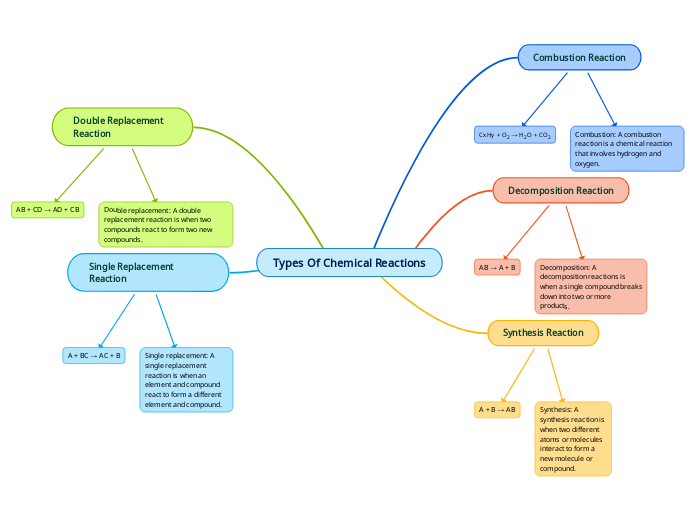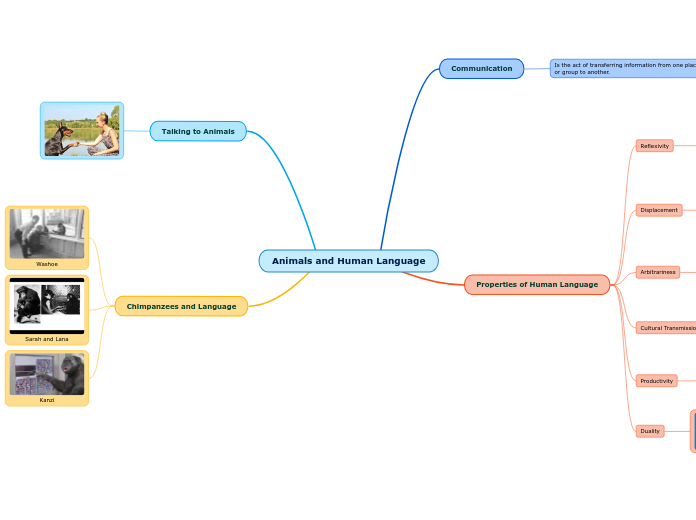Special Cases of Chemical Reactions
By Shela Lamug
Book Cited
“1- McGraw-Hill Ryerson - High School Chemistry 11 v4.Pdf.” Google Drive, Google, docs.google.com/file/d/0B6S8xw_R2yByWVVxNV80Yk4xZ1U/view.
Double Displacement
Occurs when two ionic compounds exchange places, creating two new ionic compounds. Usually seen as, AX + BY → AY + BX
A Reaction that
Structures a Gas
When a gas is produced from a double displacement reaction, this is due to two reasons; an acid and a compound containing a carbonated ion producing an ionic compound, water, and carbon dioxide, or a compound containing ammonium ions and hydroxide ions producing an ionic compound, water, and ammonia.
In this example, the ammonium chloride reacts with the sodium hydroxide to produce the sodium chloride, water, and ammonia.
NH4Cl (aq) + NaOH (aq) → NaCl (aq) + H2O (l) + NH3 (g)
Reactants:
1 N
5 H
1 Cl
1 O
1 Na
Products:
1 N
5 H
1 Cl
1 O
1 Na
A Reaction That
Structures a Liquid
(Neutralization)
Neutralization occurs when a base and an acid reacts and water is produced as one of the products. In this example, calcium displaces H2 and sulfate displaces water.
H2SO4 (aq) + Ca(OH)2(aq) → CaSO4 (s) + 2H2O (l)
Reactants:
4 H
1 S
6 O
1 Ca
Products:
4 H
1 S
6 O
1 Ca
A Reaction That
Structures a Solid
The product's state can be predicted using the solubility guidelines. It states many patterns which can be used to predict whether or not the double displacement reaction will occur or not. In this example, the Cation replaces the cation or the anion replaces the anion.
AgNO3 (aq) + NaCl (aq) → AgCl (s) + NaNO3 (aq)
Reactants:
1 Ag
1 N
3 O
1 Na
1 Cl
Products:
1 Ag
1 N
3 O
1 Na
1 Cl
Single Displacement
Occurs when an elements takes the place of another element from a compound. Often seen as A + BX → AX + B, where the cation displaces another cation or AX + Y → AY + X, where the anion replaces the other anion.
A Metal Displacing a
Hydrogen from an
Acid or Water
Hydrogen has a 1+ charge will allows it to become replaced by a metal from an acid or a base. In doing so, hydrogen gas is produced. In this example, magnesium displaces hydrogen, producing magnesium chloride and elemental hydrogen as products.
Mg(s) + 2HCl (aq) → MgCl2(aq) + H2(g)
Reactants:
1 Mg
2 H
2 Cl
Products:
1 Mg
2 H
2 Cl
A Non-Metal Displacing
Another Non-Metal to
Form an Ionic Compound
For a non-metal to displace another metal in an ionic compound, the non-metal replacing has to be located at a higher position within the reactivity of metals chart. In other words, the metal replacing has to be more reactive that the metal it is replacing.
In this example, bromine is higher than iodine in the reactivity chart. Thus, bromine can displace iodine.
2KI(aq) + Br2(l) → 2KBr(aq) + I2(s)
A Metal Displacing
Another Metal to
Form an Ionic
Compound
For a metal to displace another metal in an ionic compound, the metal replacing has to be located at a higher position within the reactivity of metals chart. In other words, the metal replacing has to be more reactive that the metal it is replacing. In this example, copper displaces silver and elemental silver are created as products. Since copper is located higher on the activity series metal, it can displace silver.
2AgNO3(aq) + Cu(s) → Cu(NO3)2(aq) + 2Ag(s)
Combustion
Combustion is when an oxygen reacts with a hydrocarbon. In doing so, heat and light energy are created.
Incomplete
Incomplete combustion are less efficient and more hazardous because it produces yellow light, soot, CO2, CO, along with water vapour.
2C3H8 (g) + 7O2 (g) → 2C (s) + 2CO (g) +2CO2 (g) + 8 H2O (g)
Reactants:
6 C
16 H
14 O
Products:
6 C
16 H
14 O
Complete
With increased amount of oxygen, more complete reactions can occur and less soot is formed. This is because more oxygen causes the gas molecules in the flame to become ionized. Thus, when the hydrocarbon burns with a sufficient amount of oxygen, the flame becomes hotter and more efficient.
CH4(g) + 2 O2(g) → CO2(g) + 2 H2O(g)
Reactants:
1 C
4 H
4 O
Products:
1 C
4 H
4 O
Decomposition
A decomposition reaction is the process of breaking down of a compound.
A Metal Hydroxide
Decomposing into a
Metal Oxide and Water
The products of a metal hydroxide consist of a metal oxide and water. In this example, sodium oxide and water is produced.
2NaOH(s) → Na2O(s) + H2O(g)
Products:
2 Na
2 O
2 H
Reactants:
2 Na
2 O
2 H
A metal nitrate decomposition
into a metal nitrate and
oxygen gas
When compounds are composed of more than two elements, they will not break down into each individual element. Instead, the poly atomic compound will decompose into a compound similar to the reactant.
2 Mg(NO₃)₂(s) → 2MgO(s) + 4NO₂ (g) + O₂(g)
Reactant:
2 Mg
4 N
12 O
Products:
2 Mg
4 N
12 O
A Binary Compound
Decomposes Into
its Elements
Through electrolysis, compounds can be separated into their elements. In this example, sodium chloride breaks down to elemental sodium and elemental chlorine through electrosis.
2 NaCl (l) → 2 Na (l) + Cl2 (g)
Reactants:
2 Na
2 Cl
Products
2 Na
2 Cl
Synthesis
- Synthesis reactions consist of two or more simple substances reacting in order to produce one complex compound. Commonly seen as A+B→ AB.
Two Compounds Forming
a New Compound
A Metal Oxide
Reacting with Water
When a metal reacts with water, acid is produced. In this example, Magnesium Hydroxide is produced from combining magnesium oxide and water.
MgO + H2O → Mg(OH)2
Reactants :
1 Mg
2 2
1 2
Products:
1 Mg
2 2
1 2
A Non-Metal Oxide
Reacting with Water
Acid precipitation is produced when a non-metal combines with water. This is because carbon dioxide and sulfur trioxide are extremely polluting.
SO3 (g) + H2O(l) → H2SO4 (aq)
Reactants:
1 S
4 O
2 H
Products:
1 S
4 O
2 H
An Element and a Compound
Forming a New Compound
Instead of an element and another element combining, a compound can also combine with an element through synthesis.
2 CO(g) + O2(g) → 2CO2(g)
Reactant:
2 C
4O
Products:
2 C
4O
Two Elements Forming
a Binary Compound
Two Non-Metals
Combine to Form a
Molecular Compound
Since a two non-metals are reacting, electrons are shared. This is because the have low ionization energy. In this example, hydrogen and nitrogen are reacting to produce ammonia.
3 H2(g) + N2(g) → 2 NH3(g)
Reactants:
6 H
2 N
Products:
6 H
2N
Multivalent Metal Reacting
with a Non-metal to Form
Various Compounds
When a metal has more than one charge reacts with a non-metal, various compounds can be formed. In this example, copper is used as a reactant, along with chlorine. Two products can be produced from each different copper ion when it reacts with chlorine or any other non-metal.
For example,
2 Cu (s) + Cl2 (g) → 2 CuCl (s)
Cu (s) + Cl2 (g) → CuCl2 (s)
Univalent Metal Reacting
with a Nonmetal to Form
an Ionic Compound
In order to react, the electrons from the univalent metals are transferred onto the non-metals, creating an ionic compound. For the reaction between potassium and chlorine gas, 2 potassium atoms and 2 chlorine atoms are needed in order for the chemical equation to become balanced and for the net charge of the compound equal to zero.
2 K(s) + Cl2(g) → 2 KCl(s)









